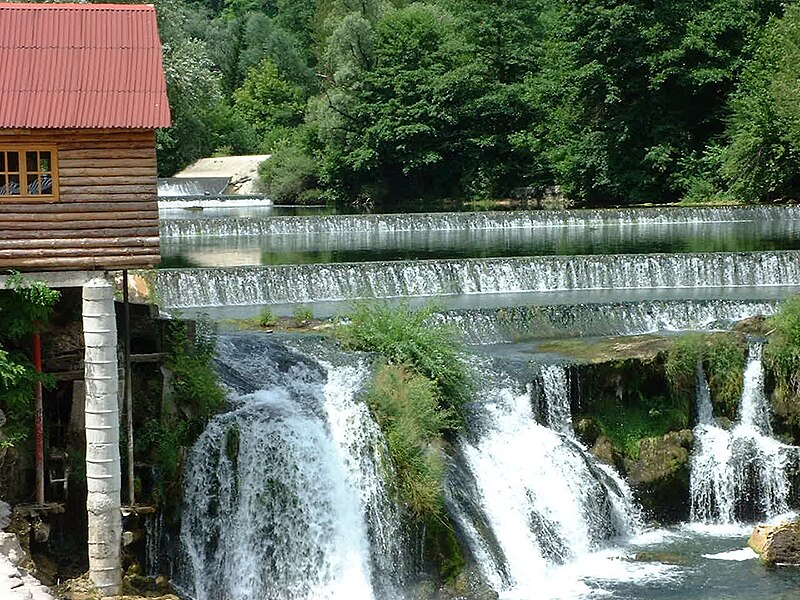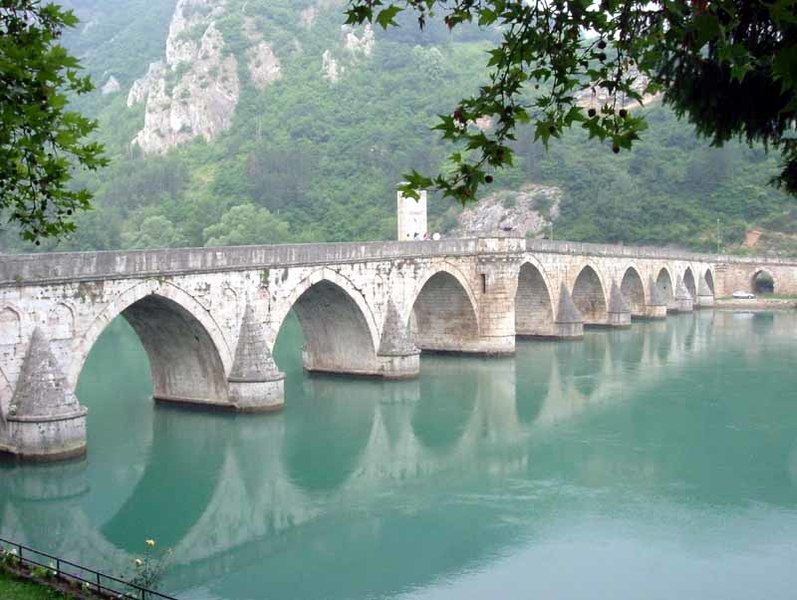This is the first of a series of Around the World Wednesday essays giving a brief history & overview of countries around the world. While browsing through old notebooks, I found this essay I wrote several years ago on Bosnia-Herzegovina which, revised and updated, will serve as the first post of this series.
Psalm 46:8-10
"Come, behold the works of the Lord, what desolations he hath made in the earth. He maketh wars to cease unto the end of the earth; he breaketh the bow, and cutteth the spear in sunder; he burneth the chariot in the fire. Be still, and know that I am God: I will be exalted in the earth."
Begin at point 0,0. Travel 43 degrees, 52 minutes north and 18 degrees, 25 minutes east; you will find yourself in Southeastern Europe, in the Balkan Peninsula, north of the Adriatic Sea, to the east of Croatia, with Serbia and Montenegro to your east and southeast respectively. You will be in Sarajevo, Bosnia. Bosnia-Herzegovina, at 19,971 square miles--less than half the size of Iowa--claims 7 major rivers, several waterfalls, 16 miles of shoreline on the Adriatic Sea, one of the two surviving ancient European forests (which covers half of the country), and a 13th century fortress. Yet, this small, beautiful land has often been racked with wars and horrors.
 |
| Ostrozac Castle via Wikipedia |
Formed in 1189, Bosnia lost its independence to Ottoman Empire conquest in 1527. In 1908 it was annexed by the Austrian-Hungarian Empire. In 1914, a Serbian patriot named Gravilo Princip assassinated Archduke Ferdinand, heir to the Austrian-Hungarian throne, and his wife in Sarajevo. This sparked World War I, a war which claimed approximately 7 million lives, but left Bosnia virtually untouched. After the war, Bosnia and Herzegovina joined the South Slav Kingdom of Serbs, Croats, and Slovenes (Yugoslavia).
In 1990, Yugoslavia began to break apart as Croatia and Slovenia declared independence. The Serbs in Bosnia preferred to stay with the Yugoslav federation, but the Bosniaks and Croats wished to declare independence. In 1992, Bosnia split into the Serbian Republic of Bosnia and Herzegovina (Republika Srpska) and the Croatian Community of Herzeg-Bosnia. The Constitutional Court of Bosnia and Herzegovina declared Herzeg-Bosnia illegal.
After a referendum for independence from Yugoslavia--boycotted by Serbs--in which 99.7% of the 63.4% of people who voted voted for independence, Bosnia and Herzegovina declared independence. On April 6th, open warfare began in Sarajevo.
Secret discussions, known as the Karadordevo agreement, between Serbia and Croatia on the division of Bosnia and Herzegovina had been held as early as March 1991. Following Bosnia's declaration of independence, the Serbs attacked. The state administration of Bosnia effectively ceased to function, having lost control of its entire territory. The Serbs wanted all lands mostly populated by Serbs. The Croats also aimed at expanding their territory at the expense of Bosnia and Herzegovina. Bosnian Muslims were the only ethnic group loyal to the Bosnian government.
Republika Srpska soon had most of the country under its control. Bosniak houses and apartments were ransacked or burnt and Bosniak civilians were captured, beaten, and killed. Families were separated and massacres and atrocities were committed. Serbian forces undertook an ethnic cleansing campaign, and thousands were murdered in the Srebrenica genocide in 1995. In Sarajevo, children were a primary target for snipers, and according to one survey, after all the atrocities the children witnessed 90% claimed they did not even want to live. The Serbians were finally pushed back after a NATO bombing campaign and a ground offencive by the allied forces of Croatia and Bosnia. In December 1994, the signing of the Dayton Agreement in Dayton, Ohio by the presidents of Bosnia and Herzegovina, Croatia, and Serbia brought a halt to the fighting. Over 100,000 soldiers and civilians of all ethnicities had been killed.
Government
Today, Bosnia and Herzegovina is a federal democratic republic with a bicameral legislature and a presidency consisting of three members: one Serb, one Bosnian, and one Croat. An international civilian implementation overseer or High Representative, though not a government member, has authority to dismiss elected and non-elected officials.
Suffrage is universal. The voting age is 18; however, 16 and 17 year-olds can vote as well if they are employed.
The People and Culture
49% of Bosnians live in cities and towns. The agricultural sector, which accounts for 19% of the GDP, does not produce enough food to meet the needs of the country; so some food must be imported.
Bosnia's GDP is $32.43 billion. Bosnia's main industries are steel, coal, iron ore, lead, zinc, manganese, bauxite, vehicles, textiles, tobacco products, furniture, tanks, aircraft, oil refining, and domestic appliances. There is 44.6% unemployment, and 18.6% of Bosnians live below the poverty level. The GDP per capita is estimated at only $8,400. The public debt is 43.8% of the GDP. (See CIA World Factbook)
Bosnia has 98% literacy rate. It also has a rich culture in art, music, theater, and literature. The country also hosted the 14th Winter Olympics in 1984.
Men usually shake hands upon meeting, but among the Muslims it is forbidden for women to shake hands with men unless they are related. Families are most often patriarchal. Bosnians generally do not look each other in the eye when speaking, but look aside to promote concentration on the theme discussed. Guests always bring a small gift when visiting the homes of friends. Bosnians are known as friendly and hospitable people.
Tourist Attractions
Sarajevo is home to many museums including the National Museum of Bosnia and Herzegovina (established 1888), the Ars Aevi Museum of Contemporary Art, the Alija Izetbegović Museum, and the Museum of Sarajevo.
Bosnia is also noted for its ski slopes. Modern resorts, inexpensive passes, and reliable snowfall between December and March make it a fun for ski enthusiasts.
Other interesting locations include the Shrine of Our Lady Medjugorje, the Mehmed Paša Sokolović Bridge in Visegrad, Mostar "the City of Sunshine," the Kastel fortress, Una National Park and the waterfalls of the river Una, Sutjeska National Park (home to Bosnia's highest peak and beautiful native forest and the location of a great battle of World War II where the Partisans defeated a massive German army), the Kravica Waterfalls, Ostrozac Castle, Jajce (city of the Bosnian kings), Doboj and its 13th century fortress, Konjic and Tito's underground nuclear bunker, and the Lower Tara river canyon (the deepest in Europe).
 |
| Meeting of Chetniks and other guerrilla groups during World War II in Bosnia |
Yugoslavia was invaded by Germany on April 6, 1941, and Bosnia was ceded to the Independent State of Croatia. Croat leaders undertook to exterminate Serbs, Jews, Communists, Antifascists and others in death camps. Between 80,000-100,000 people were murdered in the Jasenovac extermination camp alone. Many Serbs joined the Chetniks, a guerilla resistance group. The Bosnian terrain provided ideal conditions for resistance. As Basil Davidson wrote, "Bosnia was the geographical mother of the partisan movement, providing ample space amongst its mountains for training and development." The Chetniks fought both the Nazis and the multi-ethnic Communist Partisans lead by Tito and eventually backed by the Allies. After the end of the war, Bosnia and Herzegovina become one of the 6 constituent Republics of the Socialist Federal Republic of Yugoslavia under Tito.
In 1990, Yugoslavia began to break apart as Croatia and Slovenia declared independence. The Serbs in Bosnia preferred to stay with the Yugoslav federation, but the Bosniaks and Croats wished to declare independence. In 1992, Bosnia split into the Serbian Republic of Bosnia and Herzegovina (Republika Srpska) and the Croatian Community of Herzeg-Bosnia. The Constitutional Court of Bosnia and Herzegovina declared Herzeg-Bosnia illegal.
After a referendum for independence from Yugoslavia--boycotted by Serbs--in which 99.7% of the 63.4% of people who voted voted for independence, Bosnia and Herzegovina declared independence. On April 6th, open warfare began in Sarajevo.
Secret discussions, known as the Karadordevo agreement, between Serbia and Croatia on the division of Bosnia and Herzegovina had been held as early as March 1991. Following Bosnia's declaration of independence, the Serbs attacked. The state administration of Bosnia effectively ceased to function, having lost control of its entire territory. The Serbs wanted all lands mostly populated by Serbs. The Croats also aimed at expanding their territory at the expense of Bosnia and Herzegovina. Bosnian Muslims were the only ethnic group loyal to the Bosnian government.
Republika Srpska soon had most of the country under its control. Bosniak houses and apartments were ransacked or burnt and Bosniak civilians were captured, beaten, and killed. Families were separated and massacres and atrocities were committed. Serbian forces undertook an ethnic cleansing campaign, and thousands were murdered in the Srebrenica genocide in 1995. In Sarajevo, children were a primary target for snipers, and according to one survey, after all the atrocities the children witnessed 90% claimed they did not even want to live. The Serbians were finally pushed back after a NATO bombing campaign and a ground offencive by the allied forces of Croatia and Bosnia. In December 1994, the signing of the Dayton Agreement in Dayton, Ohio by the presidents of Bosnia and Herzegovina, Croatia, and Serbia brought a halt to the fighting. Over 100,000 soldiers and civilians of all ethnicities had been killed.
Today, Bosnia and Herzegovina is a federal democratic republic with a bicameral legislature and a presidency consisting of three members: one Serb, one Bosnian, and one Croat. An international civilian implementation overseer or High Representative, though not a government member, has authority to dismiss elected and non-elected officials.
Suffrage is universal. The voting age is 18; however, 16 and 17 year-olds can vote as well if they are employed.
 |
| A Waterfall on the River Una |
Bosnia has a population of 3,875,723. Of these, 48% are Bosniak, 37.1% Serbs, and 14.3% Croats. Bosnian and Croatian are both official languages. The citizens of Bosnia are also divided into various religious groups: 40% are Muslims, 31% Orthodox, 15% Roman Catholic, and 14% of various other persuasions.
49% of Bosnians live in cities and towns. The agricultural sector, which accounts for 19% of the GDP, does not produce enough food to meet the needs of the country; so some food must be imported.
Bosnia's GDP is $32.43 billion. Bosnia's main industries are steel, coal, iron ore, lead, zinc, manganese, bauxite, vehicles, textiles, tobacco products, furniture, tanks, aircraft, oil refining, and domestic appliances. There is 44.6% unemployment, and 18.6% of Bosnians live below the poverty level. The GDP per capita is estimated at only $8,400. The public debt is 43.8% of the GDP. (See CIA World Factbook)
Bosnia has 98% literacy rate. It also has a rich culture in art, music, theater, and literature. The country also hosted the 14th Winter Olympics in 1984.
Men usually shake hands upon meeting, but among the Muslims it is forbidden for women to shake hands with men unless they are related. Families are most often patriarchal. Bosnians generally do not look each other in the eye when speaking, but look aside to promote concentration on the theme discussed. Guests always bring a small gift when visiting the homes of friends. Bosnians are known as friendly and hospitable people.
Tourist Attractions
Sarajevo is home to many museums including the National Museum of Bosnia and Herzegovina (established 1888), the Ars Aevi Museum of Contemporary Art, the Alija Izetbegović Museum, and the Museum of Sarajevo.
Bosnia is also noted for its ski slopes. Modern resorts, inexpensive passes, and reliable snowfall between December and March make it a fun for ski enthusiasts.
 |
| Visegrad Bridge via Wikipedia |
 |
| Mostar via Wikipedia |
Bosnia is a historical treasure trove, which though often racked by conflict, has shown its resilience through the ages.


No comments:
Post a Comment